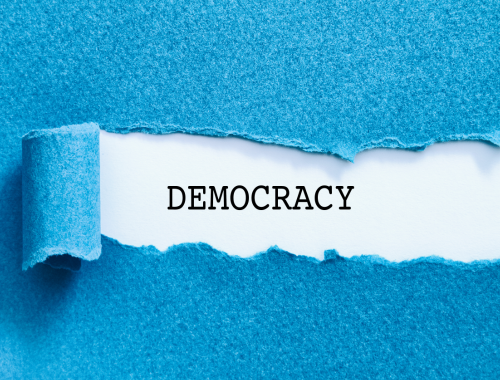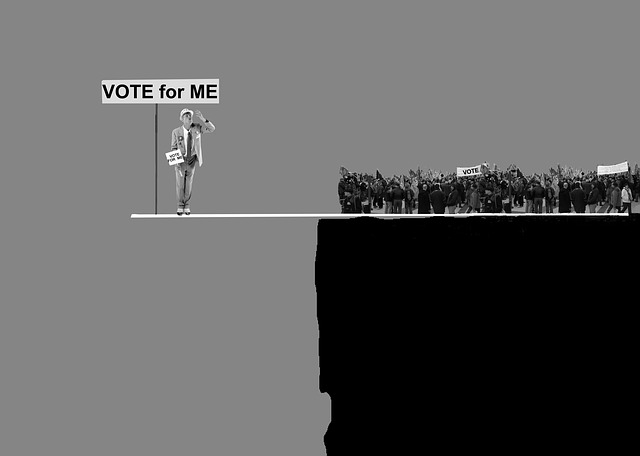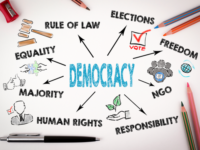
Navigating Democratic Terrain: Similarities Between Representative and Participatory Democracy
Democracy, as a form of governance, comes in various shades, with representative democracy and participatory democracy standing as prominent models. While distinct in their approaches, these two forms of democracy share fundamental similarities that underscore their commitment to citizen involvement and decision-making. This article explores the common threads that weave through representative and participatory democracy, shedding light on the shared principles that define these democratic systems.

Citizen Empowerment:
- Representative Democracy: In representative democracy, citizens empower elected representatives to make decisions on their behalf. The essence lies in the delegation of authority to elected officials who act as proxies for the electorate.
- Participatory Democracy: Participatory democracy emphasizes direct citizen involvement in decision-making. Here, citizens actively participate in shaping policies and decisions, fostering a sense of empowerment.
Informed Decision-Making:
- Representative Democracy: Elected representatives are entrusted with the responsibility of making informed decisions. They engage in debates, gather information, and deliberate on behalf of their constituents.
- Participatory Democracy: Citizens in participatory democracy are directly engaged in decision-making processes, contributing to informed discussions and debates. This direct involvement enhances the depth of understanding among the populace.
Accountability Mechanisms:
- Representative Democracy: Accountability in representative democracy is upheld through periodic elections. Citizens have the power to hold representatives accountable for their actions by voting them in or out of office.
- Participatory Democracy: Accountability mechanisms in participatory democracy are more immediate. Citizens directly witness the outcomes of their decisions, fostering a sense of responsibility and accountability.
Protection of Minority Rights:
- Representative Democracy: Representative democracy incorporates safeguards to protect minority rights. Elected representatives are tasked with ensuring that the interests of minority groups are not overshadowed by majority decisions.
- Participatory Democracy: Similarly, participatory democracy aims to protect minority rights by providing a platform for diverse voices to be heard directly. Decision-making processes include mechanisms to prevent the tyranny of the majority.
Flexible Decision-Making:
- Representative Democracy: Elected representatives have the flexibility to make decisions efficiently. This streamlined process allows for swift responses to emerging issues.
- Participatory Democracy: Decision-making in participatory democracy may be more time-consuming due to direct citizen involvement. However, this ensures a thorough and inclusive process that reflects the diversity of perspectives.
Educational Opportunities:
- Representative Democracy: Citizens in representative democracies have opportunities to be politically educated through observing debates, discussions, and policy outcomes.
- Participatory Democracy: Participatory democracy inherently provides continuous civic education as citizens engage directly in decision-making processes, deepening their understanding of governance.
Civic Engagement:
- Representative Democracy: Civic engagement in representative democracy involves voting, engaging with elected officials, and participating in advocacy efforts.
- Participatory Democracy: Civic engagement is a core principle of participatory democracy, with citizens actively participating in decision-making forums, community meetings, and policy discussions.
In conclusion, while representative democracy delegates decision-making authority to elected representatives and participatory democracy involves direct citizen involvement, both models share a commitment to citizen empowerment, informed decision-making, accountability, minority rights protection, and civic engagement. Recognizing these commonalities sheds light on the enduring principles that anchor democratic systems around the world.
Here’s a simplified comparison table highlighting the similarities between representative democracy and participatory democracy:
| Aspect | Representative Democracy | Participatory Democracy |
| Citizen Empowerment | Citizens empower elected representatives to make decisions on their behalf. | Emphasizes direct citizen involvement in decision-making. |
| Informed Decision-Making | Elected representatives make informed decisions on behalf of constituents. | Citizens actively participate in decision-making processes, contributing to informed discussions. |
| Accountability Mechanisms | Accountability upheld through periodic elections. | Immediate accountability as citizens witness the outcomes of their decisions. |
| Protection of Minority Rights | Safeguards to protect minority rights. | Provides mechanisms to protect minority rights and prevent the tyranny of the majority. |
| Flexible Decision-Making | Efficient decision-making by elected representatives. | Decision-making may be more time-consuming but ensures a thorough and inclusive process. |
| Educational Opportunities | Political education through observing debates and policy outcomes. | Continuous civic education as citizens engage directly in decision-making processes. |
| Civic Engagement | Civic engagement includes voting, engaging with elected officials, and advocacy. | Core principle involving citizens in decision-making forums, community meetings, and policy discussions. |
Both representative and participatory democracies aim to foster citizen engagement, accountability, and informed decision-making, albeit through different approaches. Understanding these shared principles provides insights into the foundations of democratic governance.
FAQ: Similarities Between Representative Democracy and Participatory Democracy
Q1: How do representative democracy and participatory democracy empower citizens?
A1: In representative democracy, citizens empower elected representatives to make decisions on their behalf, while participatory democracy emphasizes direct citizen involvement in decision-making processes. Both models aim to ensure citizens have a role in governance.
Q2: What mechanisms exist for informed decision-making in these democracies?
A2: In representative democracy, elected representatives make informed decisions through debates and deliberations. Participatory democracy involves direct citizen engagement in decision-making, contributing to informed discussions and debates.
Q3: How are accountability mechanisms similar in both democracies?
A3: Representative democracy upholds accountability through periodic elections, allowing citizens to hold representatives accountable. Participatory democracy ensures immediate accountability as citizens witness the outcomes of their decisions.
Q4: Do both democracies protect minority rights?
A4: Yes, both democracies aim to protect minority rights. In representative democracy, safeguards are in place to ensure minority interests are considered. Participatory democracy includes mechanisms to prevent the tyranny of the majority and protect minority rights.
Q5: Is there flexibility in decision-making in both democracies?
A5: Representative democracy allows for efficient decision-making by elected representatives. Participatory democracy, while potentially more time-consuming, ensures a thorough and inclusive decision-making process that considers diverse perspectives.
Q6: How do these democracies contribute to civic education?
A6: In representative democracy, citizens are politically educated through observing debates and policy outcomes. Participatory democracy inherently provides continuous civic education as citizens engage directly in decision-making processes.
Q7: What forms of civic engagement are encouraged in both democracies?
A7: Civic engagement in representative democracy includes voting, engaging with elected officials, and participating in advocacy. Participatory democracy encourages citizens to actively participate in decision-making forums, community meetings, and policy discussions.
Q8: Are there any common principles that anchor both democracies?
A8: Yes, both democracies share common principles such as citizen empowerment, informed decision-making, accountability, protection of minority rights, flexibility in decision-making, educational opportunities, and civic engagement. These principles form the foundations of democratic governance.
Understanding these shared principles helps illuminate the enduring values that characterize both representative and participatory democracies.
Q9: How do these democracies balance efficiency and inclusivity in decision-making?
A9: Representative democracy achieves efficiency through elected representatives, whereas participatory democracy, while potentially more time-consuming, ensures inclusivity by directly involving citizens in the decision-making process.
Q10: Are there instances where citizens engage in both forms of democracy simultaneously?
A10: Yes, some democratic systems incorporate elements of both representative and participatory democracy. Citizens may empower representatives while also actively participating in certain decision-making processes, creating a hybrid model.
Q11: How do these democracies address the need for continuous citizen engagement?
A11: In both democracies, citizen engagement is encouraged through mechanisms like elections, public consultations, and community involvement. Continuous civic education ensures citizens remain informed and engaged.
Q12: Can these democracies adapt to evolving societal needs and values?
A12: Both democracies are designed to adapt. Representative democracy allows for policy changes through elections, and participatory democracy accommodates evolving values by involving citizens directly in decision-making.
Q13: Do these democracies foster a sense of civic responsibility among citizens?
A13: Yes, both democracies aim to instill civic responsibility. In representative democracy, citizens are responsible for electing representatives, while participatory democracy emphasizes direct citizen responsibility in decision-making.
Q14: How do these democracies address the potential for majority dominance?
A14: Representative democracy includes safeguards to protect minority rights. Participatory democracy incorporates mechanisms to prevent the tyranny of the majority, ensuring diverse voices are considered in decision-making.
Q15: Can citizens influence policy outcomes in both democracies?
A15: Yes, citizens in both democracies have the power to influence policy outcomes. In representative democracy, this is through electing representatives, and in participatory democracy, citizens directly contribute to policy discussions.
Q16: Are these democracies adaptable to various cultural and societal contexts?
A16: Yes, both representative and participatory democracies are adaptable and have been implemented in diverse cultural and societal contexts worldwide, showcasing their flexibility as governance models.
Understanding the nuances and commonalities between representative and participatory democracy provides a comprehensive view of the democratic landscape and the various ways citizens engage in governance.












Leave a Reply